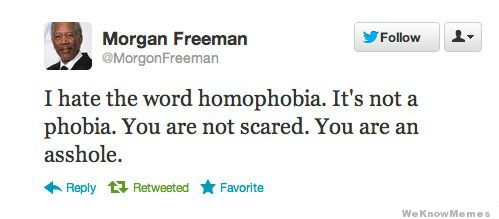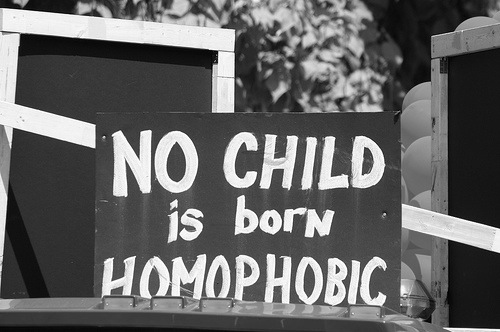Welcome to the seventh installment of More Than Words, where I take queer words of all sorts and smash them apart and see what makes them tick. Every week I’ll be dissecting a different word, trying to figure out where it came from, how it has evolved, where it might be going, and what it all means. It’s like reading the dictionary through a prism. Feel free to send word suggestions to cara@autostraddle.com.
Header by Rory Midhani

The Associated Press Stylebook is a grammar, style, and usage bible for news organizations, and those who want to write like news organizations. People generally open it if they forget what an Oxford comma is or how to pluralize buses. The guide has recently turned heads outside of its normally select purview because its editors have announced that they no longer condone the use of the suffix “-phobia” in “political and social contexts.” This means journalists that work for the AP, or any of the many other publications who use the Stylebook, will have to find other ways to describe what has traditionally been known as Islamophobia, or xenophobia or (and most directly relevant to our particular interests) homophobia. “Homophobia” has long been a controversial term, and the AP’s announcement provides a good opportunity to consider its continuing relevance or lack thereof. Many experts have already taken this opportunity, and now it’s Autostraddle’s turn to stand on their shoulders. Welcome to an exhaustive analysis of “homophobia” that doesn’t mention Fred Phelps even once!

If we’re going to grapple with this term’s future, we must first revisit its past. In the mid-1960s in Manhattan, a psychotherapy student named George Weinberg was having trouble reconciling what he saw in his everyday life with what he heard in the classroom. As a committed ally and an active part of the burgeoning homophile movement, Weinberg hung out a lot at Mattachine Society picket lines with his gay friends, who were enjoying healthy and productive lives with their cortexes intact. But as a PhD candidate at Columbia, he listened to his professors and peers deny this possibility, blaming all of their gay patients’ problems on the gay part, prescribing electroshock therapy as a cure, and taking what Weinberg describes as a “get-that-out-of-here-I’m-closing-my-eyes-I-don’t-want-to-hear-about-it” approach to any gay people they met in a nonclinical setting, and therefore weren’t actively trying to “fix.” (Like an ophidiophobe around a snake, he said, if you could turn a snake into a shoelace by zapping it.) Weinberg observed these patterns of thought and visceral reactions and, “spurred by . . . perhaps a little bit of rage,” gave them a name – homophobia. By 1967 he was using the term during academic talks, formally defining it as “a fear of homosexuals which seems to be associated with a fear of contagion, a fear of reducing the things one fought for – home and family.”
In 1969, the word appeared in print for the first time, when Weinberg’s friends Jack Nichols and Lige Clarke worked it into their column for hip tabloid Screw (that same year, TIME Magazine used it in a fairly dicey cover story about “The Homosexual in America“). Weinberg convinced a younger colleague, K.T. Smith, to draw up the first scientific study of homophobia for his Masters thesis, which was published in 1971; Smith found homophobic people to be generally “status-conscious, authoritative, and sexually rigid.” In 1972, Weinberg published Society and the Healthy Homosexual, which rounds out his definition of and theories about homophobia and explains why it, rather than the thing it fears, is the real social ill. People both within and outside of the LGBT community grabbed onto the word almost immediately – as psychologist Gregory Herek puts it, the term “crystallized the experiences of rejection, hostility, and invisibility that homosexual men and women . . . had experienced throughout their lives.” The very next year, thanks partially to lobbying from Weinberg, the American Psychological Association removed homosexuality from its Diagnostic and Statistical Manual of Mental Disorders. Being gay was, medically speaking, no longer a pathology; being anti-gay, culturally and linguistically speaking, suddenly was. It worked like a dream – proponents of gay rights suddenly had a way to describe their opponents, and these opponents were flummoxed and caught off guard. Former congressman William Dannemeyer, who has written a book attacking the gay rights movement, credited the word, along with “gay,” with “tipping the scales, perhaps irreversibly, in favor of the homosexuals.” By changing the language, Weinberg changed the conversation, and although we still have a long way to go, it seemed for a while like the dialogists’ roles were set.

But as the new year approaches, so does that potential game-changer, the 2013 AP Style Guide. The editors’ decision stems from a desire to be fairer and more specific. “A phobia is a psychiatric or medical term for a severe medical disorder,” AP Deputy Standards Editor Dave Minthorn explains. “[Using the word] homophobia . . . is ascribing a mental disability to someone, and suggests a knowledge that we don’t have. Instead, we would use something more neutral – anti-gay, or some such . . . we want to be precise and accurate and neutral in our phrasing.” An ask-the-editor blurb on the AP website follows up: “The reasons for anti-gay feelings or actions may not be apparent. Specifics are better than vague characterizations of a person’s general feelings about something.”
Whether or not you agree with the AP’s decision, it has some undeniably interesting precedents. Dissatisfaction with the word “homophobia” is as old as the term itself, and is spread across several camps. Some people are bothered because the word isn’t semantically transparent. If you break it apart and define it by its Greek roots, “homophobia” actually means “fear of sameness.” If, as some have argued was intended, you instead take the prefix “homo” as short for “homosexual,” you’re including a pejorative slur in a word meant to denote people who, say, use pejorative slurs, so that reading doesn’t really make sense either. This is troublesome for those who consider lack of precision a major linguistic sin. Other objections come from those who are traditionally described as homophobic themselves, who argue that the medical bent of the term is not only inaccurate but hypocritical and damaging. In their paper “Homophobia: Conceptual, definitional, and value issues,” psychologists William O’Donohue and Christine E. Caselles attest that using clinical language to stigmatize “certain open and debatable value positions” is just as bad as constructing homosexuality as a disease. Some gay rights activists think that this argument is strong enough to detract attention from more important issues. Zach Ford at ThinkProgress argues that although the term has been effective in the past, “the intensity of the word may have brought about its own undoing,” as the “it’s not a disease” argument has allowed anti-gay groups like the National Organization for Marriage to sidestep the bigotry associated with the word by focusing on the technical meaning it suggests. Others, such as Herek, worry that the term unintentionally propagates prejudice against mentally ill people by “conflating psychopathology with evil,” and that the blame it places on individuals obscures the need for analysis of the cultures that help shape those individuals’ attitudes and beliefs.

All good points, but do they add up to a real case for retiring the word outright? Most of the reports I read covering the story didn’t think so (and as reporters are the ones who will be most directly affected by the decision, I’m inclined to give their opinions particular clout). Language columnist Ben Zimmer takes issue with the pathologizing charge, explaining that many so-called phobias, especially social ones, aren’t medically recognized, and that for most English-speakers, the suffix just denotes an irrational prejudice. Others maintain that, clinically tested or no, anti-gay bias constitutes a true phobia. Slate Magazine’s Nathaniel Frank builds a case for that view using neuroscientific evidence, arguing that homophobia is rooted in a biological fear of outsiders. Now that “anti-gay advocates are making testable claims about specific threats,” he says – gay marriage undermines straight marriage, two moms can’t properly raise a kid, etc. – and those claims are consistently being proven wrong, this fear is officially irrational, and therefore phobic. Patrick Strudwick of the Guardian makes this same case, but cites personal experience:
“I’ve spent 30 years understanding homophobia. When you can feel its breath on your face, spitting, threatening, bullying and abusing you, one tends to be rather more adept at analysing its motives than, say, the policeman who plods in with his or her notebook. Given this, I can report with a certainty rarely enjoyed by straight journalists that being anti-gay is, without exception, at least partly fuelled by fear. Fear of the unknown, fear of unwanted sexual attention, fear of gender roles being flouted, fear of humanity being wiped out by widespread bumming, fear of a plague of homosexuals dismantling marriage, the family, the church and any other institution held vaguely dear. And, of course, never forget: fear of what lurks repressed and unacknowledged in the homophobe. Irrational fear. It’s a phobia, people.”
Weinberg certainly doesn’t want the AP to nix his word, calling it “too hard-won” and worrying that phasing it out without a proper replacement will cause widespread silencing. The Advocate or the San Diego Gay and Lesbian News don’t want to let go of the word either — each has clearly stated its intention to break with the Style Guide on this one “as long as mistruths, lies, hatred, bias, discrimination and propaganda are used by anti-gay activists to demonize the LGBT community.” So basically: we’ll drop our weapons when the other side drops theirs.
That’s a lot packed into ten letters, and I think the real problem, in the end, is that one word isn’t enough to hold all of it. The fact that the same word can be used to describe my mom’s discomfort when I held hands with my first girlfriend and a Ugandan prime minister who wants to legislate the murder of his own citizens is troubling. Maybe we need words that still acknowledge the wrongheadedness of the attitude or action, but also leave room for different levels of malicious intent. Maybe then so many necessary and worthwhile conversations wouldn’t get stopped short by “don’t call me that,” and transformed suddenly into arguments over what someone is or isn’t, rather than what they’ve done and where it might have come from. “Homophobia” is a powerful word, and this power is valuable when it’s used to describe, say, how it feels to be feared, or blatantly vindictive or bad-spirited people, organizations and actions. But, like any single cluster of letters, it lacks the subtlety necessary to deal with an issue that increasingly takes many forms. This lack of subtlety can be obfuscating, distracting, and harmful.
However, the void that results if you remove the word entirely is entirely detrimental. The AP editors drew attention to a worthy problem, but by trying to solve it by subtraction, they deny its complexity, and in the process pass up the kind of inventive linguistic challenge they should be embracing. Give us more words, not fewer, AP Stylebook! More words, because an invisible enemy is the scariest thing of all.


